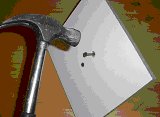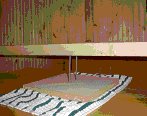 Safety Alert Safety Alert
As an educator you are responsible for the
implementation of the activities found on this site. You must have
safety procedures and rules established for you classroom and make sure
all of the students follow the rules to ensure a safe environment. South
Dakota Public Broadcasting cannot in any way be responsible or liable
for any injury as a result of using the activities. Use the activities
you feel are appropriate and safe for your individual class. Have fun
and stay safe.
Questions, comments or ideas for Kids Quest can be e-mailed to Edservices@sdpb.org
It is common knowledge that all kids love to play. Unfortunately, some of the students you have in the classroom are not as
thrilled about math, language arts or science class. Their minds may be
on recess or a television show they watched the night before. The
activity that follows is a very fun and easy supplement to bring your
class alive without straying from learning. The kids will learn and have
fun.
Activity:
The focus of the following activity
examines the affect differences in gravity have on weight. Weight and
mass are very similar but there are differences in there meaning. I have
included a clip below to help explain the topic. This is a challenging
concept for children to understand. Weight is a measure of how heavy
something is. Weight includes the effect of gravity pulling an object
toward the center of the earth. Simply stated mass is a measure of how
much matter or stuff an object has inside of it. Gravity has no effect
on the mass of an object. The video clip below shows the difference
between weight and mass. The Kids Quest episode "Fill Your Head with
Space” explains some of the concerns of weightlessness and gives the
solutions NASA used to overcome them. For your convenience, all of the
Kids Quest episodes can be viewed on line at http://www.sdpb.org Click on the
NASA web sight to view a video on line called Space Basics. The video
will explain the location of the space shuttle during a normal orbit.
Also, weightlessness is explained. http://quest.nasa.gov/space/teachers/liftoff/basics.html
Watch the Science Sample Clip (7
min)
Materials per group:
Hammer
1 8' - 2x4 board
1 12”x12”x1” board
2 long nails as fulcrum
10-20 lb. bag of potatoes (note: Rocks may work better and they are less
expensive)
6' rope to attach sacks (optional)
rubber tub
fishnet sack (note: garbage sacks or gunny sacks may work)
1 electric balance
graph paper /data paper (1 for each student)
goggles (1 per student)
note: Amounts of material may vary depending on your class size.
Procedure:
Introduction of topic (space) (1-2 class periods)
1. Watch Kids Quest " Fill Your Head With Space”.
2. Cover information in your science text about scientific method.
3. Visit educational web sites about space and gravity.
http://quest.nasa.gov/space/teachers/liftoff/basics.html
http://www.pbs.org/wgbh/nova/search-results.html?q=space
Process:
1. The activity involves the making of a balance. I will
explain one way of completing the lab below. The lab setup can be larger
or smaller to fit your needs. Your students can use their imaginations
to help figure out different ways to complete the lab. This activity is
a perfect lab to use to help students understand the basics of the
scientific method. The problem is designing a balance out of everyday
items to test the effect of buoyancy of water on the weight of objects.
The number of steps completed for the scientific method varies depending
on which book you use. Below are some sites which explain the scientific
method in detail. Also, you will find an simple example shown below.
http://biology.clc.uc.edu/courses/bio104/sci_meth.htm
http://teacher.nsrl.rochester.edu/phy_labs/AppendixE/AppendixE.html
2. I suggest the teacher should complete the building of the balance.
The students can help but it should be under the teacher's direct
supervision. Use the pictures below as reference for the steps to
follow. The 2 long nails should be driven through the 1 inch board to
produce a fulcrum for the 8ê 2x4. The nails must be sturdy to hold large
amounts of weight. (diagrams 1 and 2). The 2x4 should be centered on the
nails (fulcrum). This will produce a simple 1st class lever, which will
be used as your balance (diagram 3). The sacks should be placed on the
ends of the board. (I admit this is a lot of work but the kids will love
it. Also, you can use it forever because teachers can never afford to
retire.) The construction is complete. Once the lever is built, it can
be used for different labs.
 Fig 1 Fig 1  Fig 2 Fig 2  Fig 3 Fig 3
3. The 10-20 lbs. of potatoes or rocks should be divided evenly and
placed in the two-fishnet sacks. The sacks should be tied to the balance
and allowed to hang. The balance should be level. Move the potatoes or
rocks if needed to level the balance. Place a small beach ball in the
sack that will be lowered into the water.
4. Take the large tub and fill it with water. Both sacks should still be
attached to the balance. Place one of the sacks in the water. The
buoyant force of the water will push up part of the weight. Now remove
the potatoes or rocks from the other side until the system is balanced.
The weight of the potatoes or rocks removed should be measured using an
electronic bathroom scale or science balance. Note: You may not have a
balance so you could count the number of rocks or potatoes removed. This
will equal the buoyant force of the water. Record this amount on the
data sheet. (note: Rocks may be better because they are usually more
dense resulting in less material used.)
5. Note: This can be a frustrating step. I have used fishnet before and
tied it into the shape of a sack. This allows the water to flow in
between the potatoes. Then I placed a small, deflated beach ball in the
sack under the potatoes or rocks. Small amounts of air can be blown into
the ball increasing the buoyancy. The potatoes placed in the water will
be pushed up because volume is increased. The extra air will act like a
small life jacket. Repeat step 4. Continue to add more air to the sacks.
Repeat step 4 after each small amount of air is added. You should have
approximately 10 readings. (2nd option: A garbage sack or baggy could be
used for the air, but the amount introduced is harder to control.)
6. The activity is perfect because the students can visually see the
effect of the buoyant force on the weight of the object. This is very
similar to the effect of weightlessness an astronaut would experience in
orbit. The mass is the same, but the weight appears to change. The
easiest way to experience a space walk is going swimming in a pool.
Cool!!!
7. With your help, the students can construct the graph. A graph could
be made comparing the data sample with the apparent weight loss.
8. The activity can be modified to meet your needs.
9. This lab takes practice and patience. It may take a few times to
master a technique that works for you. The data may not be perfect the
first few times. That is ok because the students will still understand
buoyancy and have fun.

(example graph - can be completed on paper)
(does not represent actual data)
State Standards:
If completed correctly, the
following standards are used in the activity above. More standards could
be used by including spin-offs of the activity. For example, a paper
could be written about Archimedes' Principle and its affect on weight. http://www.state.sd.us/deca/OCTA/contentstandards/index.htm
Number indicates standard number
FIFTH GRADE ALGEBRA STANDARDS- THE STUDENT WILL:
8. analyze tables and graphs to identify properties and relationships.
9. represent situations and number patterns with concrete materials,
tables, graphs, verbal rules, and algebraic notation. (could expand the
data)
FIFTH GRADE MEASUREMENT STANDARDS - THE STUDENT WILL:
7. use appropriate tools to measure length, weight, temperature, volume,
and area.
11. use and evaluate strategies to make measurement estimates.
FIFTH GRADE NUMBER SENSE STANDARDS- THE STUDENT WILL:
13. solve problems using non-routine strategies. (using the constructed
balance as estimation)
FIFTH GRADE PATTERNS, RELATIONS, AND FUNCTIONS STANDARDS - THE STUDENT WILL:
2. analyze how change in one variable causes a change in another.
(example: holding area constant and changing length and width)
(increased surface area - increased buoyant force)
6. use information from a graph or equation to answer questions about a
problem situation or to create a "story".
FIFTH GRADE STATISTICS & PROBABILITY STANDARDS- THE STUDENT WILL:
1. collect, organize, and display data in a variety of forms.
FIFTH GRADE NATURE OF SCIENCE STANDARDS- STUDENTS WILL:
2. identify and model characteristics of scientific thinking. (designing
a balance with class)
3. explain how scientific theory, hypothesis generation, and
experimentation are interrelated.
6. formulate hypotheses based on cause and effect relationships and use
observed patterns to make predictions.
7. make predictions, utilize observations, and draw conclusions.
8. define variables that must be held constant in a specific
experimental situation.
9. collect, record, and report data using the appropriate graphical
representation. (example: graphs, charts, and diagrams)
10. recognize numerical data that are contradictory or unusual in
experimental results.
11. use appropriate scientific equipment for investigations.
12. use proper safety procedures in all investigations.
FIFTH GRADE PHYSICAL SCIENCE STANDARDS- STUDENTS WILL:
9. explain that every object in the universe has mass and therefore
gives rise to a gravitational force on every other object.
11. analyze the structure and design of simple and complex machines to
determine how the machines make work easier. (expand on the 1st class
lever)
Resource: South Dakota Department of Education Content Standards.
|
|